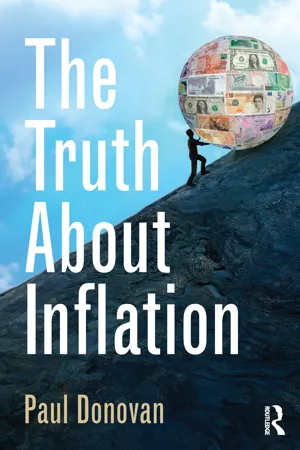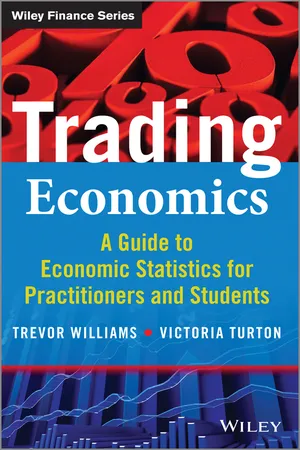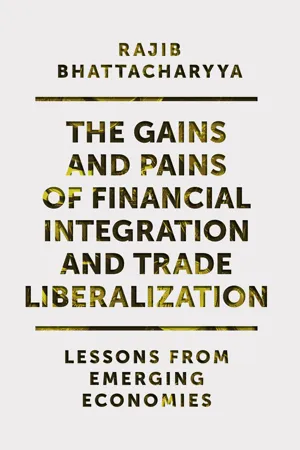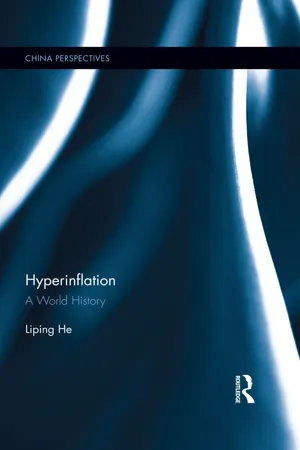Economics
Inflation and Real Exchange Rates
Inflation and real exchange rates are interconnected economic concepts. Inflation refers to the general increase in prices of goods and services, leading to a decrease in the purchasing power of a currency. Real exchange rates, on the other hand, take into account inflation and reflect the relative price levels between two countries. Changes in inflation can impact real exchange rates and international trade competitiveness.
Written by Perlego with AI-assistance
Related key terms
7 Key excerpts on "Inflation and Real Exchange Rates"
- eBook - ePub
Terms of Trade
Glossary of International Economics
- Alan V Deardorff(Author)
- 2014(Publication Date)
- WSPC(Publisher)
page 362 ).Real effective exchange rateThe effective exchange rate (page 126 ) adjusted for the rates of inflation (page 221 ) in each country.Real exchange rate1. The nominal exchange rate (page 308 ) adjusted for inflation. Unlike most other real (page 363 ) variables, this adjustment requires accounting for price levels in two currencies. The real exchange rate is: R = EP* /P where E is the nominal domestic-currency price of foreign currency, P is the domestic price level, and P* is the foreign price level.2. The real price of foreign goods; i.e., the quantity of domestic goods needed to purchase a unit of foreign goods. Equals the reciprocal of the terms of trade (page 429 ). Equivalent to definition 1.3. The relative price of traded goods (page 445 ) in terms of nontraded goods (page 312 ).Real GDPThe real counterpart to nominal GDP (page 308 ), obtained by valuing output in a given year at prices from another year, called the base year (page 28 ).Real interest rateThe nominal interest rate adjusted for inflation (page 221 ), to get the percentage yield an asset holder receives in terms of real resources. Equals the nominal interest rate minus the rate of inflation.Real modelAn economic model without money. Most general equilibrium (page 184 ) models of trade are real models. This includes the Ricardian model (page 378 ), the Heckscher-Ohlin Model (page 199 ), and the models of the new trade theory (page 306 ).Real money balancesThe real (page 363 ) value of the amount of money (page 287 ) held by a person, household, or firm, or the amount in circulation in the economy.Real national incomeNational income (page 297 ) adjusted for inflation (page 6 ).Real termsSame as real (page 363 - eBook - ePub
- Paul Donovan(Author)
- 2015(Publication Date)
- Routledge(Publisher)
Economic models abound regarding inflation prediction; most of them are relatively dreary, many are far too mathematical in their approach, and few are of any real use to the investor or consumer trying to think about inflation. Instead of presenting a model for forecasting inflation, therefore, this book tries to present a means for understanding inflation. Understanding what inflation is, and what it is not, is something that is increasingly missing from investment decisions. A proper understanding of why inflation cannot and should not be reduced to a simplistic single figure will prevent investors making potentially damaging decisions. It also identifies some of the challenges policymakers face in balancing the competing forces of perception and reality. This opening chapter therefore aims to set out what inflation actually is. Like any good economics student, it is as well to begin by defining the terms that are to be used. Once we have established what the word ‘inflation’ really means, we can get down to the serious business of debunking the myths that surround the idea, and end up by trying to consider inflation in a way that is useful. So what is inflation? At its most crude, inflation is the rate of change in prices. Which immediately raises the question: what is a price? A price represents a standardised and mutually agreed measure of what one person is prepared to receive in exchange for whatever goods or services that they can provide. Nowadays we tend to standardise prices in terms of money (meaning notes and coins, or more likely their virtual, electronic equivalent) but it could be anything. The cow has been a medium of exchange for millennia, perhaps for longer than any other form of physical currency. Sea shells, cigarettes, split lengths of a stick – anything will do, and all in their turn have been major forms of currency (in America, Germany and England, respectively) - eBook - ePub
Trading Economics
A Guide to Economic Statistics for Practitioners and Students
- Trevor Williams, Victoria Turton(Authors)
- 2014(Publication Date)
- Wiley(Publisher)
4 InflationInflation is always and everywhere a monetary phenomenon in the sense that it is and can be produced only by a more rapid increase in the quantity of money than in output.Milton Friedman1WHAT IS INFLATION?
Inflation tells us the changing (increasing) price of a range of goods or services; basically how much of something we can get for our money. The rate of change of prices – the speed at which the price of goods and services that are bought by households or businesses alter – is called inflation. But prices can also fall, in a process called deflation, sometimes termed negative inflation. Inflation is more common than deflation, or at least it has been in the last 50 years or so, and so it has become associated with changes in the price of goods and services. Historically, however, price falls were as common as price rises, as we will see later.Both inflation and deflation have advantages and disadvantages, which we will explore in more detail later in this chapter.THE HISTORY OF INFLATION
Inflation has been around for a long time, but, as Figure 4.1 shows, the level of prices (the index) really only rose consistently and sharply in the UK from the 1970s onwards. This was after the US came off the gold standards and the Bretton Woods system of fixed exchange rates, which had prevailed after the Second World War, ended. Money was now backed by government fiat and trust rather than by gold. And exchange rates were no longer fixed but allowed to float freely. This seems to have led to a rapid rise in the level of prices or, in other words, to the Retail Prices Index. Before that, for hundreds of years, the level of the index barely changed, as periods when it was rising were matched by periods when it was falling.Figure 4.2Figure 4.1Price index over time.Source: ONS. - Imad A Moosa(Author)
- 2013(Publication Date)
- WSPC(Publisher)
This is an index that shows how the price of a (hypothetical) basket of goods and services (called the market basket) changes over time. Another point to bear in mind is that not all price rises are inflationary. For example, prices may rise because of the imposition of new taxes or rising tax rates. Yet another observation is that inflation refers to a “sustained” or long-term rise in the general price level, not a one-off increase resulting, say, from a temporary bad harvest or a one-off hike in the price of crude oil. Inflation is, therefore, a continuous rather than discrete process. 1 Some economists, however, do not share this view, describing one-off price hikes as “inflationary bursts”. 2 Inflation is a dynamic process — it is about rising prices over time, not about prices being high at a particular point in time. Prices could be high but the inflation rate could be zero; or, prices could be low but inflation could run at a high rate. Naturally, inflation leads over time to a high level of prices. As we are going to see, some economists believe that inflation is purely a monetary problem resulting solely from monetary growth, which is nothing but an increase in the money supply over time. While not all economists subscribe to this view, most economists believe that (at least in the long run) inflation, whatever its cause may be, must be validated by an increase in the money supply (otherwise it will be suppressed inflation). The extreme monetary view is that there is a proportional relation between growth in the money supply (monetary growth) and inflation. The idea is actually intuitive. An increase in the money supply makes money less valuable in terms of goods and services whose prices rise. Those who believe in this process tend to define inflation as a sustained increase in the money supply causing a sustained decline in its value- eBook - ePub
The Gains and Pains of Financial Integration and Trade Liberalization
Lessons from Emerging Economies
- Rajib Bhattacharyya(Author)
- 2019(Publication Date)
- Emerald Publishing Limited(Publisher)
2016) for details). This is particularly true post 2008–2009, where we can decipher that high values of exchange rate are congruent with high inflation rate and low growth rate of GDP. Especially, post 2009–2010, while exchange rate started heading northward, GDP growth rate marched southward. On the other hand, both CPI inflation and exchange rate went hand in hand, on an upward trajectory (on an average).Fig. 14.1.Indian Growth, Inflation, and Exchange Rate.Source: RBI, Author's Calculations.Investment, trade, and capital flow channels are the routes through which India's growth rate is affected. Let us explain. First, India's major driver of growth has been investment, which is highly dependent on import of oil, capital, and intermediate good, and thus, exchange rate. A rise in exchange rate (fall in R/$ rate) raises profitability of investment by reducing the cost of import as well as raises the net worth of firms and reduces the latter's external finance premium. Further debt of firms (serviceable in terms of domestic goods) also affects investment adversely. A rise in exchange rate increases value of debt in terms of domestic currency (and also in real terms), adversely affecting investment. Thus, low exchange rate is a beneficial factor for high growth. Secondly, India's exports are highly import-intensive (like import of oil, gems, raw materials, chemicals, capital goods, etc.). Therefore, a rise in exchange rate does not lead to much improvement in the net export of the country. Let us elaborate. A rise in exchange rate makes imports costlier. Since a rise in cost of imports feeds into the price of exports by raising it, it raises costs of imports for foreign countries, thereby not leading to a sufficient rise in exports. Finally, a rise in exchange rate feeds into the domestic price level (though imperfectly) and reduces real value of money holding or wealth, reducing consumption (through real balance effect) and hence, aggregate demand. From Fig. 14.1 - eBook - ePub
Hyperinflation
A World History
- He Liping(Author)
- 2017(Publication Date)
- Routledge(Publisher)
6 includes, mainly because prices of food and fuels tend to be more vulnerable than others to short-term shocks. Without these two, Core CPI may show relatively stable movement over time or mostly reflect the effects of economic activity within a country. GDP deflator – an implicit price deflator for gross domestic product – is a comprehensive measure of price changes in both the production and consumption sectors of an economy. Its scope is much wider than those of CPI, PPI, RPI, or WPI. Usually the information of GDP deflator is published on quarterly base, so that it has a lower frequency than many other price indexes.Sometimes, when no price index information is available, other indicators may serve equally well for gauging inflation or possible hyperinflation. Interest rates and exchange rates are such indicators. In theory, interest rates and exchange rates change quickly and accordingly when price inflation is happening, because participants in credit markets or foreign exchange markets should be able to properly adjust their use of money based upon observed and anticipated price changes. Even if price index information is available, interest rates or exchange rates can be used either to confirm the occurrence of hyperinflation or to reveal its impacts in the economy.Usually when hyperinflation takes place, the domestic credit and foreign exchange markets of the country concerned are in chaos. Consequently, black markets for credit and foreign exchange typically emerge, and people tend to rely on interest rate and exchange rate information derived from these unofficial markets as it reflects actual market transactions.In absence of all of the above-mentioned price indexes and interest and exchange rates, inflation or hyperinflation may be gauged by reference to the prices of single commodities. In Asia, price information about rice provides a good example in this regard.Collecting price information is time-consuming and costly. As a result, compiling and publishing price information on a regular basis and in a transparent way is a public service provided by government. Yet, in reality, governments from time to time attempt to distort price information for short-term political gain. The Economist , the weekly periodical based in London, once suspended the inclusion of the Argentine CPI in its regular tabulation of the latest international macroeconomic data on suspicion of the Argentine government’s manipulation of the information.7 - eBook - ePub
- China Development Research Foundation(Author)
- 2014(Publication Date)
- Routledge(Publisher)
If labor markets were perfectly competitive, then wages of non-traded sectors would increase correspondingly, leading prices of non-traded goods to increase as well. Suppose that international prices are not affected: then prices of traded goods will be determined by the international market and will not be influenced by changes in productivity or wages. Eventually, prices of non-traded goods will rise as well and the real exchange rate of the economy’s currency will appreciate.Under a system in which exchange rates are fixed, the primary channel through which the ‘real exchange rate’ can be expressed is through domestic prices, which will rise. Under a system in which the exchange rate is flexible, the way the ‘real exchange rate’ will be expressed is through appreciation of the currency. This may also be accompanied by the requisite amount of inflation.If government does not intervene in the currency markets, the exchange rate will adjust on its own, responding to productivity increases. So-called ‘pressure to appreciate’ will not exist. Another factor, therefore, leading to a currency’s ‘pressure to appreciate’ is government intervention – whether that is through the adoption of a fixed exchange-rate system or the adoption of other ‘non-clean’ systems that prevent spontaneous adjustments in supply and demand relationships of the exchange-rate market.Pressure on a currency to appreciate has both internal and external aspects. Theoretical analysis has focused mainly on internal aspects. Very little systematic analysis has been done that looks at such ‘external’ aspects as political issues.Internal pressure on a currency to appreciate is manifested mainly in the ‘release’ or increase in basic money supply, and the resulting risk of inflation and an asset bubble. Under most circumstances, pressures on currency to appreciate are the result of inventions by monetary authorities in their foreign exchange markets. Another common result of the intervention of monetary authorities in foreign exchange markets is the release of large quantities of one’s own currency in the market in the course of purchasing foreign currencies. If the speed of currency intervention is too great, that is, too much of one’s own currency is released too quickly, inflation and an asset-price bubble may result.
Learn about this page
Index pages curate the most relevant extracts from our library of academic textbooks. They’ve been created using an in-house natural language model (NLM), each adding context and meaning to key research topics.






